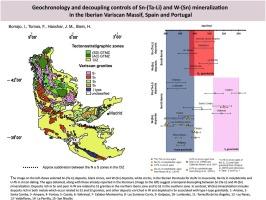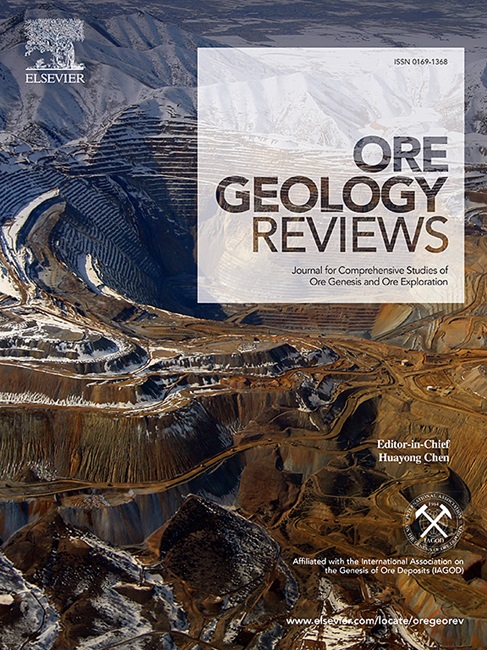Geochronology and decoupling controls of Sn-(Ta-Li) and W-(Sn) mineralization in the Iberian Variscan Massif, Spain and Portugal
IF 3.2
2区 地球科学
Q1 GEOLOGY
引用次数: 0
Abstract
Sn-W mineralization in the Iberian Variscan Massif (corresponding with the western zone of the Iberian Peninsula, in Spain and Portugal) occurs closely related to metaluminous to peraluminous granitoids of Variscan age. The deposits are grouped into two main styles of mineralization; Sn-(Ta-Li) and W-(Sn) deposits. Within this work we present a first attempt to correlate timing of W-Sn mineralization and plutonic events at a regional scale. We report new 40Ar/39Ar dates of muscovite related to the quartz-muscovite alteration of eleven deposits, molybdenite Re-Os dates from six deposits and two new zircon U-Pb dates of granitoids genetically related to the mineralization. The dates obtained support the relationship between W-Sn mineralization with specific, but not uniquely just one, granite suites. The dominant S-type peraluminous Variscan granitic suites in Iberia, the S1-type dated at ca. 330–311 Ma and the S2-type at ca. 314–296 Ma, are related to both, Sn-(Ta-Li) and W-(Sn) mineralization. A subgroup of deposits of the W-(Sn) group, generally enriched only in W but not in Sn is associated with the youngest but volumetrically less abundant I-type (ca. 303–280 Ma) metaluminous magmatism. The relationship of both the Sn-rich and W-(Sn)-rich deposits with the highly peraluminous S-type granites suggest that the ultimate source of the melts is not related to the decoupling between Sn and W. Therefore, the causes of W and Sn separation may be related to late-stage magmatic and magmatic-hydrothermal processes.

西班牙和葡萄牙伊比利亚瓦里斯坎地块锡-(钽-锂)和钨-(锡)矿化的地质年代和解耦控制因素
伊比利亚瓦里斯坎地块(相当于西班牙和葡萄牙的伊比利亚半岛西部地区)的锡-钨矿化与瓦里斯坎时代的金属铝质至过铝质花岗岩密切相关。这些矿床主要分为两种成矿类型:锡-(钽-锂)矿床和瓦-(锡)矿床。在这项研究中,我们首次尝试在区域范围内将钨锡矿化时间与成岩事件联系起来。我们报告了与 11 个矿床的石英-绿泥石蚀变有关的新的绿泥石 40Ar/39Ar 年代,6 个矿床的辉钼矿 Re-Os 年代,以及与矿化有关的花岗岩的两个新的锆石 U-Pb 年代。所获得的日期证明了 W-Sn 矿化与特定的花岗岩套件之间的关系,但并非只有一种花岗岩套件。伊比利亚最主要的 S 型过铝瓦里安花岗岩岩套,S1 型的年代约为 330-311 Ma,S2 型的年代约为 330-311 Ma。伊比利亚的主要 S 型瓦里坎过铝花岗岩岩套(S1 型的年代约为 330-311 Ma,S2 型的年代约为 314-296 Ma)都与矿石有关。伊比利亚的主要 S 型瓦里坎花岗岩岩套(S1 型的年代约为 330-311 Ma,S2 型的年代约为 314-296 Ma)都与锡(钽锂)和钨(锡)矿化有关。W-(Sn)矿床群的一个子群通常只富含 W 而不富含 Sn,与最年轻但体积较小的 I 型(约 303-280 Ma)金属铝岩浆活动有关。富Sn和富W-(Sn)矿床与高铝质S型花岗岩的关系表明,熔体的最终来源与Sn和W的脱钩无关,因此,W和Sn分离的原因可能与晚期岩浆和岩浆-热液过程有关。
本文章由计算机程序翻译,如有差异,请以英文原文为准。
求助全文
约1分钟内获得全文
求助全文
来源期刊

Ore Geology Reviews
地学-地质学
CiteScore
6.50
自引率
27.30%
发文量
546
审稿时长
22.9 weeks
期刊介绍:
Ore Geology Reviews aims to familiarize all earth scientists with recent advances in a number of interconnected disciplines related to the study of, and search for, ore deposits. The reviews range from brief to longer contributions, but the journal preferentially publishes manuscripts that fill the niche between the commonly shorter journal articles and the comprehensive book coverages, and thus has a special appeal to many authors and readers.
 求助内容:
求助内容: 应助结果提醒方式:
应助结果提醒方式:


